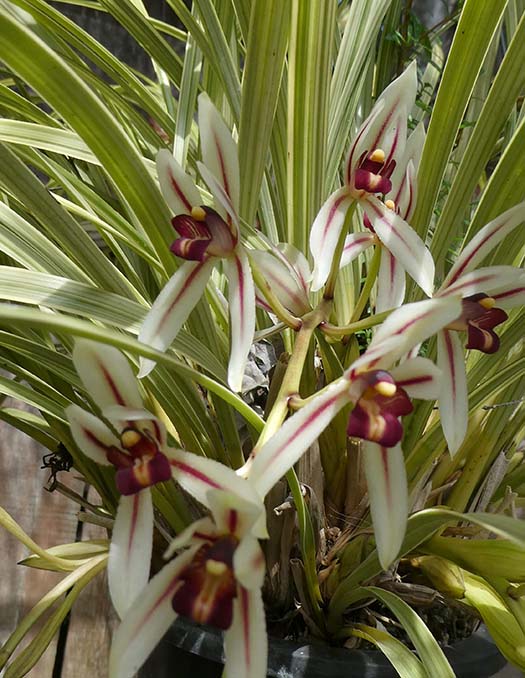October 2022 |
Show and Tell
From Kurt Shanebeck:
|
|
Outdoors coastal, north of Los Angeles:A challenging month for my orchids. The heat wave we had a few weeks ago was tough on some of my plants (temperature hit 110) especially the masdevallias (not surprising), and some plants in bud had damaged flowers. Here are some of the blooms that came through okay. All grown outdoors. |
|

Cattleya (Laelia) colnagoiA rupiculous laelia from Brazil. Growing potted in bark/granite mix with bright light. |
|
Prosthechea rhynchophora (syn. Encyclia)Grown mounted with moderately bright light. |
|

Gomesa radicans (syn. Ornithophora)Native to Brazil. Lush grass-like foliage produces many tiny (1/4”) flowers. Grows potted under moderate light. |

Miltonia clowesiiNative to Brazil. Growing potted under bright light. |
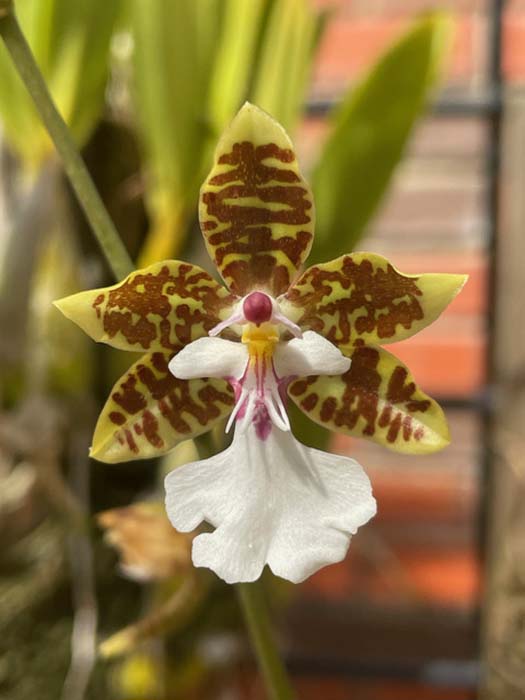 |
 |
Oncidium leucochilumNative to Mexico and Central America at elevations up to 2000m. Growing mounted with moderately bright light. |
|
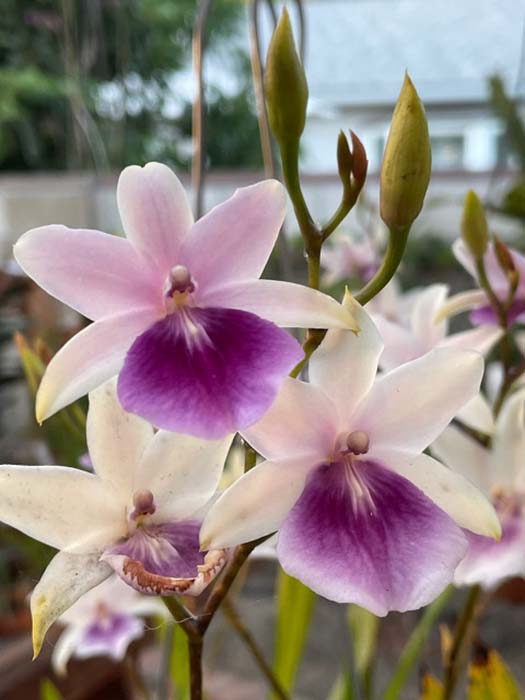
Miltonia regnelliiNative to Brazil. Growing potted with bright light. |

Rhynchostele bictoniense (syn Lemboglossum)Native to Mexico. Upright spikes. Growing potted with moderately bright light. |
 |
 |
Vanda testaceaGrowing mounted with bright light. |
|
 |
Vanda falcata (syn. Neofinetia)Growing mounted under bright light.
|
From Ed Lyszczek:
|
|
Coastal, California Central Coast |
|
Guarianthe (Cattleya) bowringianaHere are standard Cat. bowringiana and a coruela form ‘Blue Angel’. Both grow very well in my greenhouse which gets into the low 40’s on winter nights and in the high 90’s during hot summer afternoons. Watered daily in summer and fertilized at half strength every one to two weeks, Spring through Autumn. |
|
Stanhopea oculatait grows in my intermediate greenhouse (very overgrown at the moment with way too many orchids) in a wire basked lined with sphagnum moss and filled with coarse bark. The scent of this Stanhopea is mint-like and I think it smells exactly like mint chocolate chip ice cream. |
|
From Chris Ehrler:
|
|
Coastal, California Central Coast |
|
Dendrochilum magnumGrows in the Philippines as a cool growing epiphyte at elevations of 1600 to 2000 meters. Grown in a cool greenhouse in a plastic container filled with a bark and lava rock mixture. |
|
 |
|
Dracula ripleyanaA cool growing epiphyte that is thought to be native to Costa Rica. Grown in a plastic mesh pot filled with sphagnum moss in a cool greenhouse. |
|
Epidendrum porpaxA hot to cool growing, mat forming epiphyte found in Mexico, Guatemala, Honduras, Nicaragua, Costa Rica, Panama, Colombia, Venezuela, Ecuador, Peru, Bolivia and Brazil in wet montane and cloud forests at elevations of 400 to 1800 meter. This orchid is currently growing on a piece of wood with some sphagnum moss at the root. This orchid is growing well on a piece of manzanita that is suspended vertically but I plan to switch it to a larger and wider piece of redwood and orient it horizontally to see how it grows better in a different orientation. |
|
 |
 |
Pleurothallis bothosA warm to cool growing epiphyte found in Costa Rica at elevations around 750 to 2400 meters. This plant is growing in a clay pot filled with sphagnum moss which is placed in a cool greenhouse. |
|
 |
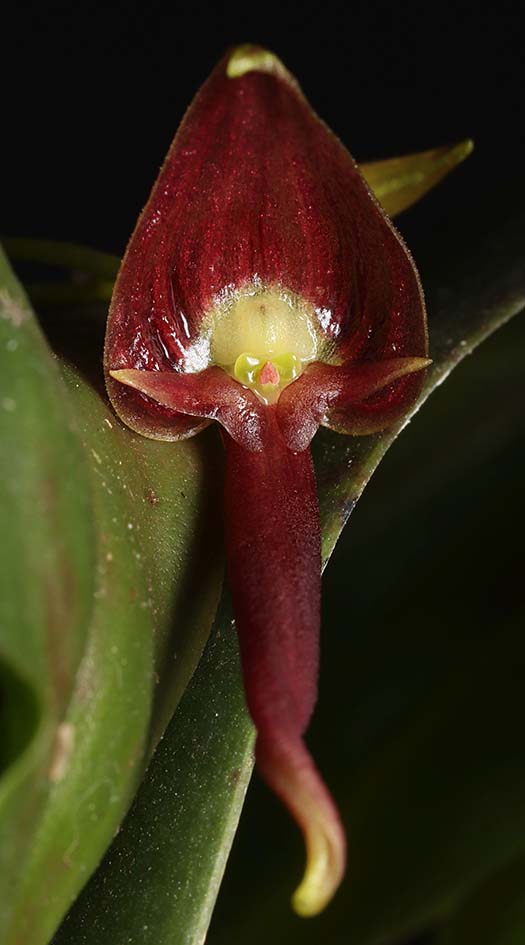 |
Pleurothallis ruberrimaFound in elevations of 750 to 2800 meters in Colombia, Ecuador, Peru, Bolivia and Venezuela in wet montane forests as a warm to cold growing terrestrial or epiphytic species Currently growing in a cool greenhouse in a sphagnum moss filled clay pot. |
|
From Scott McGregor:All orchids grown outdoors, coastal southern California |
|
|
|
Arundina graminifoliaRumored to require warm to hot conditions, this bamboo-like terrestrial thrives outdoors here in full sun. Acquired as a $5 plant in a plastic bag at the Kona (Hawaii) airport, it has turned into a “bush” about 4’ tall and 3’ in diameter. Flowers are produced at successively at the end of each mature cane. There is a short, 12-16” varietal (revoluta) of this species that I recently de-flasked. Looking forward to those seedlings blooming in the next few years! |
|

Cattleya (Sophronitis) pygmaeaThe mini of the Sophronitis group, but pretty and worth growing. |

Ceratostylis retisquama (rubra)Grows below 500 meters in the Philippines, but seems to be happy outdoors here. |
 |
 |
Cleisocentron gokusingiiBlue! |
|
Dendrobium victoria-reginaeBlooms at various times during the year and prefers cool/moist conditions. The violet flowers have blue overtones. |
|
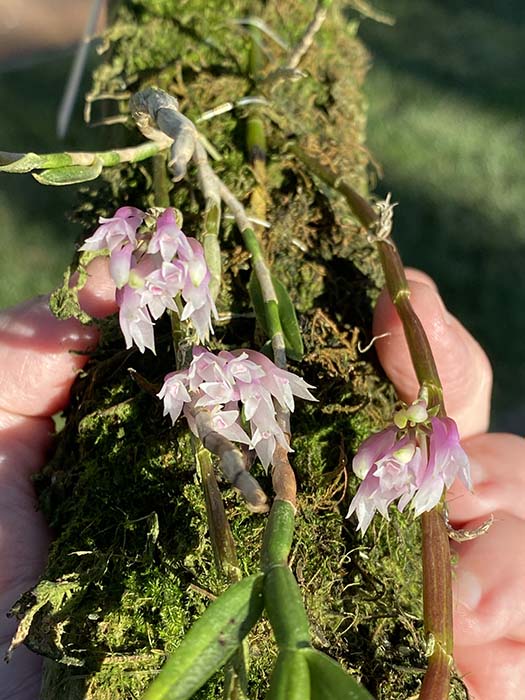 |
 |
Dendrobium caliculimentum (dichaeoidies type 3)An odd species from New Guinea, likes it cool and moist. |
|
 |
Cynorkis fastigiataI had planned to harvest seeds from C. fastigiata (the weed orchid) to give to some people, but I was too slow as the pods ripened, opened and dispersed all their seeds over the two weeks I was away! This orchid goes from flower to seed in about 6 weeks. Hopefully some will germinate on the ground and I’ll collect them. |
From Roberta Fox:
|
|
Outside in the Back Yard: |
|

Acianthera hystrix ( Pleurothallis raduliglossa)I don't know how much credit I can take on these, got the plant in March, definitely not in bloom. Flowers are about 5 mm (1/4 inch) long and maybe 2 mm wide. Teensy. Leaves about 2 cm (a bit under an inch). From Brazil, cool-growing.
|
|
 |
|
Acianthera (Pleurothallis) strupifoliaSecond time this year that it has bloomed. It comes from a range of elevations in Brazil, grows cool and shady. |
|
Aerangis mystacidiiFrom a wide area of southeast Africa, it grows over a range of elevations. Grown shady and damp, but dries quickly. Lightly night-fragrant. |
|

Cattleya forbesiiNot the most impressive Cattleya, but it is nearly bulletproof. It's very cold-tolerant, and also blooms 2 or 3 times a year. It transmits both characteristics to its hybrids. |
|
 |
|

Miltonia candidaGrows over a range of 500 to 800 m in southern Brazil. This seems to suddenly be Miltonia season... several species blooming at the same time. |
|

Cymbidium dayanumThis cultivar has variegated leaves. It is getting ready ot outgrow its pot again. |
|

Encyclia alataNative to Mexico and Central America. It probably would grow better a bit warmer, but it does grow and bloom. It is quite fragrant. |
|

Gurarianthe (Cattleya) bowringianaLast month I showed you the coerulea form. This is the typical form. |
. |
.jpg)
Cattleya bicalhoi (Laelia dayana)You saw Scott's... this one is mine. The flower is as big as the plant. |
|
 Miltonia moreliana 'Candella's Delight'
|
 |
 Miltonia moreliana
|
 |

Miltonia regnelliiHere are both the typical and aurea forms. The "tipo" flowers are a bit larger and flatter, but the color of the aurea form is (to my eyes) more interesting. So I enjoy growing both. |
|
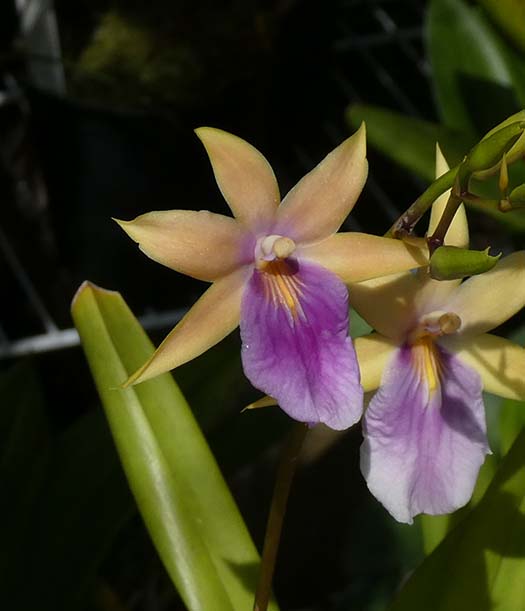 |
|
Miltonia spectabilis f. bicolorFlowers reflex so form isn't great, but it's nice to have yet another color variety. |
|
 Polystachya subdiphyllaMost Polystacya species are warm growing, but this one comes from around 2000 m. in Tanzania, and grows cool and shady on my patio. |
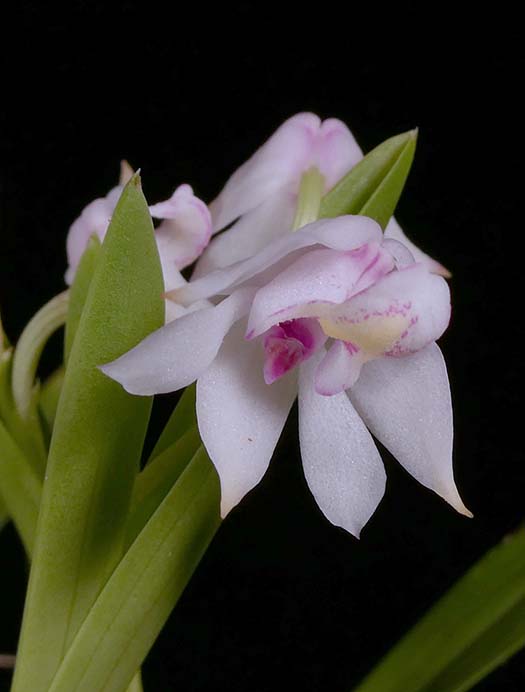 |
 |
|
Prosthechea prismatocarpaNative to Costa Rica and Panama, at elevations from 1200 to 1360 m. |
|

Sobralia fimbriataSmall short-lived flowers, but fringes everywhere. |

Sobralia sp.Labeled Sobralia macra, but it isn't. Sob. macra can be fairly tall and rangy, while this one is not much over 2 ft. tall. Along with the "normal" growths (leaves, with flowers at the top of the growth) it has some shorter growths without leaves that can also produce flowers. |
 |

Stanhopea oculataA couple of months ago I showed a species labeled "Stanhopea bucephalus" that is considered a form of Stan. oculata but had no spots. THIS one is the classic Stanhopea oculata, full of spots or "eyes", living up to its name. It has a light, pleasant fragrance. |
 |
|
 |

Stanhopea wardiiThis species has a heavy, almost musky fragrance. This plant has produced several inflorescences, that are blooming in sequence. Eah set of flowers lasts only a few days, but a multi-spike plant can be in bloom for several weeks. Another Stan. wardii also has mulitple spikes, and so I have another couple of weeks of enjoying the lovely fragrance and weird flowers. |
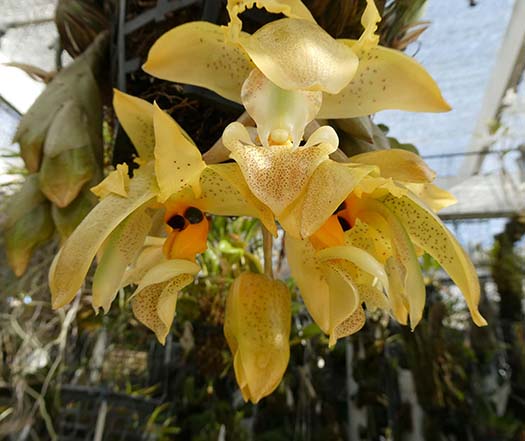 |
|

Telipogon astroglossusThis is a micro-mini plant with half-inch flowers, and a wonderful fringed lip. It bloomed in May, and now I have another set of flowers, larger than the plant. Most Telipogon species come from high elevations and tend to not survive our summers. This comes from a lttle lower, and seems to do fine. It looks more like Trichoceros than the usual round Telipogon. |
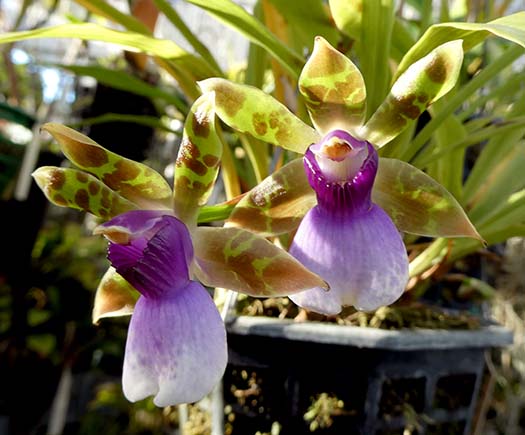
Zygopetalum maxillareI'm not sure why, but these flowers always make me smile. It grows in a basket, in sphagnum. |
In the greenhouse... |
|
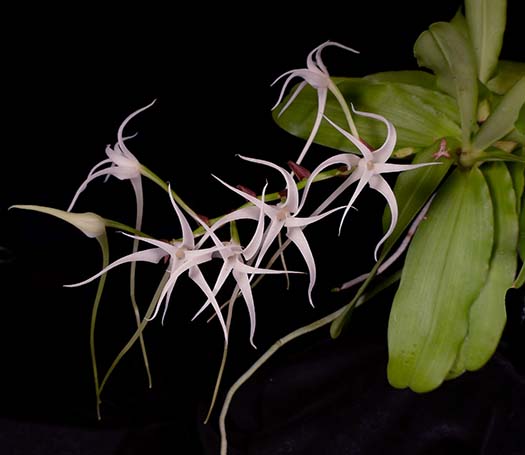
Cyrtorchis chailluanaFrom central and west Africa. It is night-fragrant. |
|
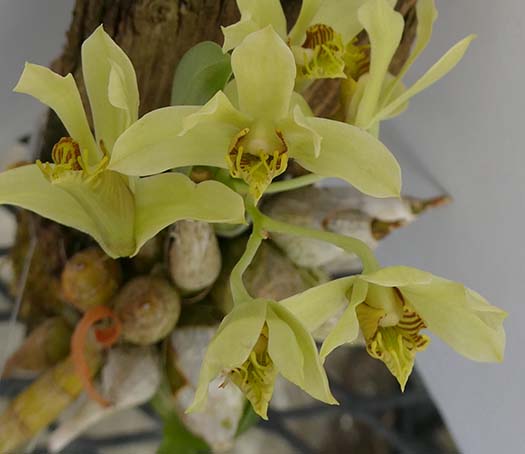
Dendrobium venustumIt was the intricate, fringed lip that attracted me. It is native to a wide area of souteast Asia, at elevations from 300-600 m. It possibly could grow cooler, but is doing so well in the greenhouse that I'll just leave it there, it is small and doesn't take up much space. It is deciduous, but it doesn't get dried out in winter and seems to bloom well anywan. |
 |
Phalaenopsis tetraspis f. imperatrixThis species, like its close relative Phal. speciosa, can produce flowers with different combnations of white and red on each flower. This color form produces a large proportion of red flowers with just a bit of white on the tips of the segments, bu here I got one with a lot more white. |
|




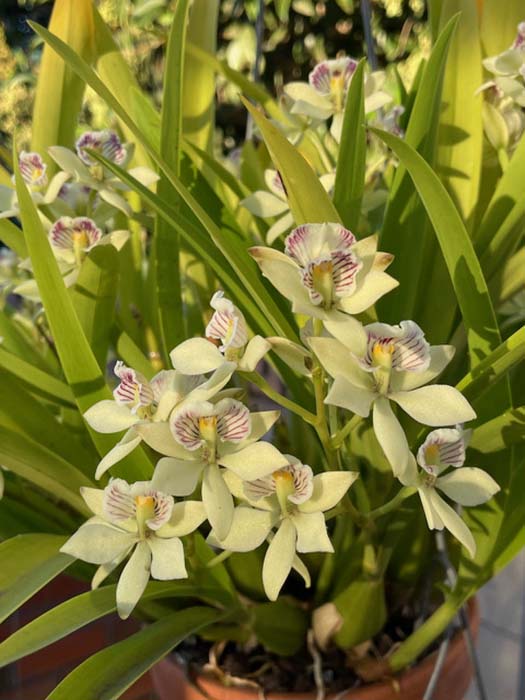





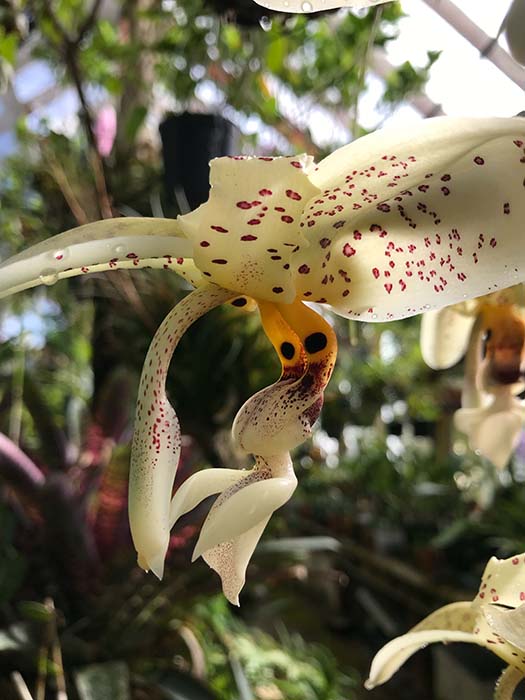



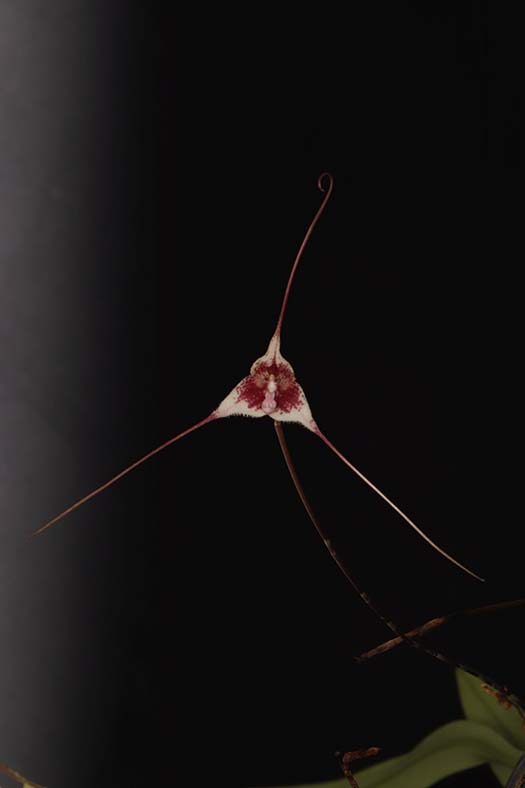








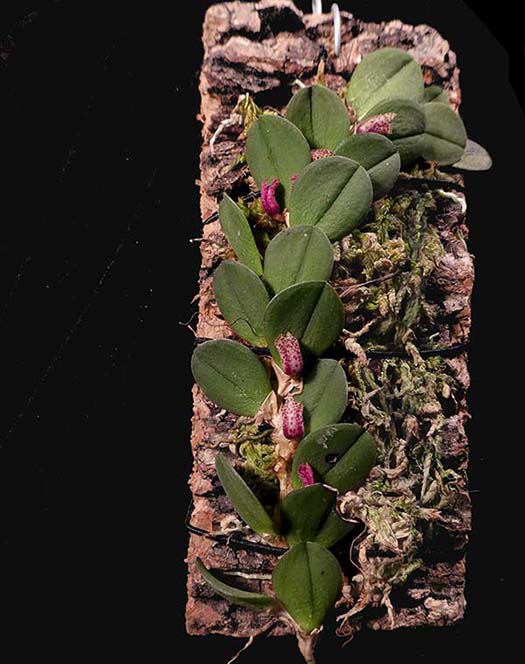


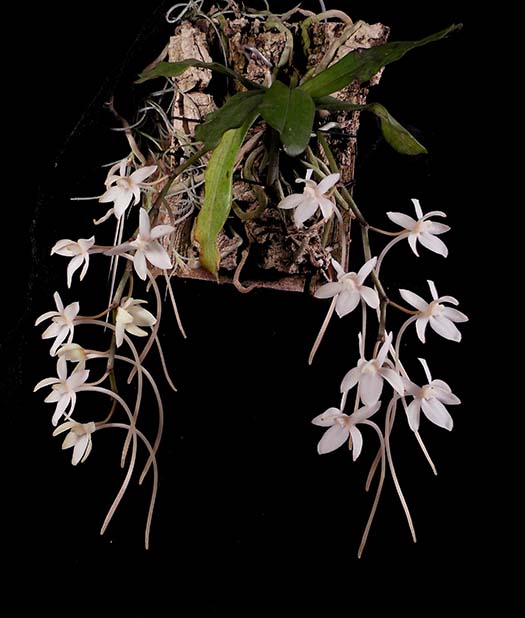


 reichenbachiana 2.jpg)


